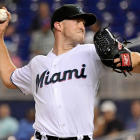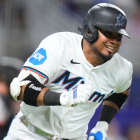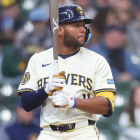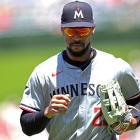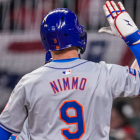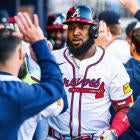Major League Baseball's annual trade deadline is just over two weeks away. Teams have already started swapping pieces ahead of July 31, which, beginning this season, will serve as the only deadline. Afterward, clubs will be unable to make trades of any variety. More deals are coming, and you can bet that they'll be accompanied with even more rumors of potential activity.
We aren't the idle type here at CBS Sports. As such, we've decided to spend the month taking inventory of certain teams' stock, highlighting individuals who could be on the move. Indeed, last week we covered why the Texas Rangers could run the pitching market if they decide to sell. Today, we're going to look at another seller with intriguing pitchers -- the Miami Marlins.
Unlike with past trades made under Bruce Sherman's ownership group (which includes Derek Jeter), whatever deals the Marlins make this deadline won't be motivated by cutting costs. Rather, they'll be operating like your typical seller. And while the Marlins are a dreadful team -- they have the fifth-worst record and run differential in the majors -- they do have a competent pitching staff, one that advanced metrics consider superior to some contenders' staffs.
So, who might the Marlins move -- and what makes them appealing to contenders? Let's dig in, with the eight pitchers below listed in order of the perceived likelihood of a trade.
These pieces almost always start with a veteran reliever who is months from free agency, and well, this one is no exception. We're giving Sergio Romo the top spot because of his track record, his willingness to do whatever the team wants (remember, he made it cool for Ryne Stanek to "open" games), and his maintained excellence versus right-handed batters. Were this post published a year ago, this is where we'd identify him as an August trade candidate. Under the new rules, Romo will probably be sent to a contender in July for a meager return.
At one point, Nick Anderson was a middling pitcher in the Frontier League. Now, he's an attractive trade candidate whose best days could be ahead of him. Anderson has a high-quality breaking ball that he could probably stand to throw more, as well as a rising mid-to-upper-90s heater. He's an extreme fly-ball pitcher, which is a tenuous thing to be in a league with a juiced ball. But Anderson has good stuff and his peripherals suggest he's better than his 93 ERA+ indicates. The Marlins have no reason to hold onto him long-term -- he's a 29-year-old rookie reliever -- and they can use the Peter Fairbanks trade as a blueprint for a deal of their own.
A fair amount of what we wrote about Anderson also applies to Austin Brice, who is 27 years old and enjoying his first sustained success in the majors. Brice is more inclined to get a groundball, however, and doesn't throw as hard. He has a high-spin curveball that he uses a lot -- to good effect, mind you -- though the pitch offers little depth due in part to his sidearm release point. Because Brice has a shiny ERA, we suspect the Marlins may overplay their hand with asks for him. Hence ranking Brice below Anderson, even if the case for trading either is the same.
Although it would be a shame for the Marlins to trade Jarlin Garcia -- therefore depriving the world of the "Jarlin the Marlin" nickname -- he is said to be on the market. Garcia has taken well to a full-time bullpen role, proving particularly effective against left-handed batters. He occupies an unusual space as he's more of a contact manager than a bat misser. You would think a 26-year-old southpaw with a sub-3.00 ERA, three pitches, and oodles of remaining team control would be interesting … but Garcia isn't, really. He's fine.
As we reported elsewhere, league sources have informed CBS Sports that the Marlins have placed Trevor Richards on the trading block. Their reasoning is straightforward: They have more young starters who they want in their rotation than they have available spots. Richards, 26, has one of the game's best changeups. He also has more than 200 league-average innings under his belt and another five seasons of team control remaining. In other words, there's a lot to like here. The Marlins are said to be asking for a lot in return, but any contender who wants a long-term rotation piece could do worse than checking in to see if the ask has gone down. One evaluator estimated there's about a 40 percent shot of a deal happening before the deadline.
Adam Conley is essentially a younger Jake Diekman. In the past, he's shown flashes of being an effective late-inning reliever. Unfortunately, this season he's posted a 7.43 ERA and has seen his secondary offerings lose effectiveness. He's not even terrorizing lefties this season -- which would seem to be a birthright for him due to his long limbs, crossfire delivery, and lower arm slot. Conley is almost certain to be non-tendered at year's end -- he's out of options and arbitration eligible -- but if Diekman can keep finding takers then maybe some enterprising team will want a firsthand look under Conley's hood to see if they can make the necessary tweaks.
Jose Urena is on the 60-day injured list and has been since early June with a herniated disc in his back. He won't be eligible to return until mid-August. Yet the Marlins have shown a willingness to move him and it's at least conceivable a deal could occur where Miami receives a player to be named later contingent on his recovery and his workload. It's more likely, in our mind, that he's dealt during the winter when he'll have two years of team control left.
We'll finish up with Caleb Smith, who the Marlins do not intend to trade according to league sources. Smith was authoring a breakout tale earlier in the season, but has since missed a month due to injury. He's back now, and isn't going anywhere -- at least for now.




























